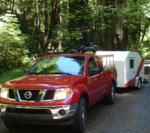New Wind Wing - Effective or not? An ongoing question.
29 posts
• Page 2 of 2 • 1, 2
That looks pretty good, Dale. I wonder if air getting under the wing might hinder the performance of the wing itself?
-

Cliffmeister2000 - Titanium Donating Member
- Posts: 3622
- Images: 157
- Joined: Thu Jul 26, 2007 10:18 pm
- Location: Phoenix, AZ
My apologies if I am trying to teach my grandmother to suck eggs, but do you know about 'coast-down' testing? This would be the obvious way of testing this wing reasonably accurately - things like mpg over a journey have all sorts of other variables (like wind/weather) that are hard to keep constant.
Plus you would get to drive up and down the same bit of road testing out different wing angles until most of the local population comes out to see what's going on.....
This web page even has a method and spreadsheet that enables you to calculate your drag coefficient:
http://www.instructables.com/id/Measure ... -your-car/
However, this does require a manual transmission so that may rule it out.
Plus you would get to drive up and down the same bit of road testing out different wing angles until most of the local population comes out to see what's going on.....
This web page even has a method and spreadsheet that enables you to calculate your drag coefficient:
http://www.instructables.com/id/Measure ... -your-car/
However, this does require a manual transmission so that may rule it out.
-

angib - 5000 Club

- Posts: 5783
- Images: 231
- Joined: Fri Apr 30, 2004 2:04 pm
- Location: (Olde) England






